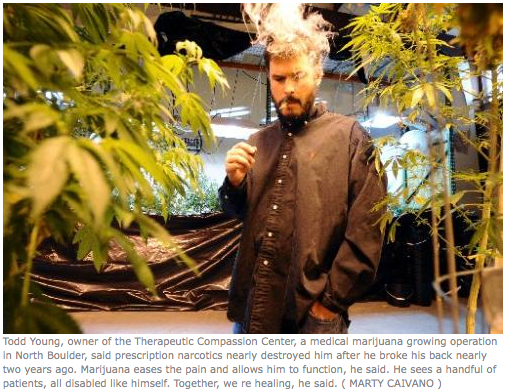December 9, 2009 – If you want to watch a trial where the defendant has no moral culpability, is prevented from testifying  truthfully and where the prosecution distorts an otherwise reasonable law beyond all rationality, you can see one this month right in Somerville. John Wilson, a multiple sclerosis patient treating himself with home-grown marijuana, is charged with operating a drug manufacturing facility. There is no charge, nor any evidence whatsoever, that he supplied or intended to supply marijuana to anyone but himself.
truthfully and where the prosecution distorts an otherwise reasonable law beyond all rationality, you can see one this month right in Somerville. John Wilson, a multiple sclerosis patient treating himself with home-grown marijuana, is charged with operating a drug manufacturing facility. There is no charge, nor any evidence whatsoever, that he supplied or intended to supply marijuana to anyone but himself.
An individual with no prior record growing marijuana plants for home use should be eligible for pre-trial intervention; but this case is being handled by the state’s Organized Crime/Gangs Unit. Wilson refused to plead guilty and accept several years in prison (a potential death sentence), so the state is seeking the maximum 20-year sentence. To justify its “manufacturing” charge, the state determined that every day a plant grew constituted a separate offense. It matters not a whit that the statute (N.J.S.A.2C:35-1.1 et seq.) is intended to combat drug distribution chains and those who pose the greatest danger to society. It ignores a statutory intent focused on harm to victims and the actor’s role in a drug distribution network. Section 4 of the statute even excludes coverage where an individual is compounding or preparing the substance for his own use.
The state senators who sponsored our long-overdue and aptly named Compassionate Use Act passionately expressed their dismay over this prosecution, calling it “a severe, inappropriate, discompassionate and inhumane application of the letter of the law.” Sen. Scutari went on to label it “cruel and unusual to treat New Jersey’s sick and dying as if they were drug cartel kingpins” and characterized it as a waste of taxpayer money. Sen. Lesniak observed, “Without compassion and a sense of moral right and wrong, laws are worth less than the paper they’re printed on.”
This brutally honest and on-target criticism has drawn accolades from around the country. Lawmakers obviously “get” the difference between drug cartel criminals and suffering people who turn to medical marijuana out of desperation. Even though the law does not currently recognize medical marijuana use as a defense, it does not require that the figurative book be thrown at a patient.
To compound the cruel absurdity of this prosecution, it is being conducted with full awareness of legislative action that would protect Wilson from a prison sentence. New Jersey’s Senate passed the Compassionate Use Act, and it has been favorably voted out of the Assembly Health Committee. Once technical revisions are completed, it is expected to pass the full Legislature, and Gov. Corzine has stated publicly that he would sign it. Informed and enlightened people accept the voluminous scientific evidence of the efficacy of marijuana to alleviate the nightmare of multiple sclerosis and many other conditions.
Outrageously, but understandably, the prosecution desperately wants jurors to be denied all the truly relevant facts. It has fought to forbid Wilson from mentioning his disease, that marijuana has been proven to be an effective palliative for multiple sclerosis, that he was using it solely for that purpose, that 13 other states have legalized it for that purpose and that New Jersey is about to. All the jurors will be allowed to hear is evidence proving Wilson “manufactured” marijuana. This is the type of injustice one is accustomed to seeing in a dictatorship — not in America.
Wilson’s plight is additional evidence that our nation’s founders were wise indeed when they recognized the crucial role “jury nullification” plays in any democratic system of government. Our founders knew that there are times when, to do actual justice, jurors must refuse to follow the letter of the law and act on their instincts of what is right. But if we expect trial by jury to continue to be the final bulwark against unjust prosecutions, jurors must have the truth. They will not get it in court in this case.
Instead of seeking justice, the Attorney General’s Office wastes public resources, its power, its credibility and worst of all, its integrity to inflict inhumane punishment on a suffering patient who merits no blame, a patient whom legislators are working to protect. It is execrable that it tortures the law to demand a maximum prison sentence on a patient suffering a crippling, incurable disease for conduct that helped him, harmed no one and that will soon be as legal as it has always been moral.
In the strife of every battle for human rights, someone is the last one martyred. Despite overwhelming evidence that John Wilson is a patient and not a drug kingpin, it is shameful that the state Attorney General’s Office knowingly and aggressively seeks to sacrifice him. Is this to be what is allowed to pass for justice in New Jersey?
Edward R. Hannaman, an attorney from Ewing, is a member of the board of the Coalition for Medical Marijuana New Jersey (CMMNJ).







 Todd Young is concerned.
Todd Young is concerned. from her doctor after suffering more than a decade of debilitating, undiagnosed pain, she had no idea where to go to get her medicine.
from her doctor after suffering more than a decade of debilitating, undiagnosed pain, she had no idea where to go to get her medicine. “We cannot have a Wild West-type situation where we have dispensaries on every corner like convenience stores,” said state Sen. Chris Romer, D-Denver, who plans to introduce legislation next year that would eliminate retail-style dispensaries and place extra scrutiny on patients under 25.
“We cannot have a Wild West-type situation where we have dispensaries on every corner like convenience stores,” said state Sen. Chris Romer, D-Denver, who plans to introduce legislation next year that would eliminate retail-style dispensaries and place extra scrutiny on patients under 25. Cannabis Therapy Institute, an advocacy group. “All that’s new is it’s coming out of the black market. This is what the legalization of a previously criminal enterprise looks like.”
Cannabis Therapy Institute, an advocacy group. “All that’s new is it’s coming out of the black market. This is what the legalization of a previously criminal enterprise looks like.”
